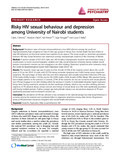Risky HIV sexual behaviour and depression among University of Nairobi students

View/
Date
2015-04-11Author
Othieno, Caleb J
Okoth, Roselyne
Peltzer, Karl
Pengpid, Supa
Malla, Lucas O
Type
Journal ArticleMetadata
Show full item recordAbstract
Abstract
Background
Prevalence rates of human immunodeficiency virus (HIV) infection among the youth are disproportionately high compared to that of other age groups in Kenya. Poor mental health has been linked to risky HIV behaviour, yet few local studies have explored these aspects. This study sought to determine associations between HIV risky sexual behaviour and depression among undergraduate students at the University of Nairobi.
Method
A random sample of 923 (525 males and 365 females) undergraduate students was interviewed using a questionnaire to record sociodemographic variables and risky sexual behaviour including having multiple sexual partners, inconsistent condom use and engaging in sex after drinking. Depressive symptoms were measured using the Centre for Epidemiological Studies Short Depression Scale (CES-D 10).
Results
The students’ mean age was 23 years (s.d.4.0). Overall, 41.33% of the students scored above the cut-off point of 10 on the CES-D 10 scale, with 35.71% having moderate symptoms and 5.62% having severe depressive symptoms. The percentage of those who had ever been diagnosed with sexually transmitted infections (STIs) was 9.71% (males 8.65%; females 11.01%); and for HIV 3.04% (males 2.02%; females 4.05%). Nearly 30% reported having had multiple partners in the previous 12 months, 27.4% of the students did not use condoms with sexual partners and 21% had engaged in sex after drinking within the previous 3 months. In multivariable-bivariate logistic regression, being older, having depressive symptoms, alcohol use/binge drinking, tobacco use, sex after drinking, previous diagnosis of STI, physical abuse, sexual coercion and history of sexual abuse as a child were significantly associated with having multiple partners. Further, younger age, being female, tobacco use and previous diagnosis of STI were significantly associated with inconsistent condom use.
Conclusion
The prevalence of HIV rate infection is low compared to the national average but risky sexual behaviour is common among the students and is positively linked to depressive symptoms among other factors. Programmes aimed at HIV prevention should be integrated with mental health interventions.
